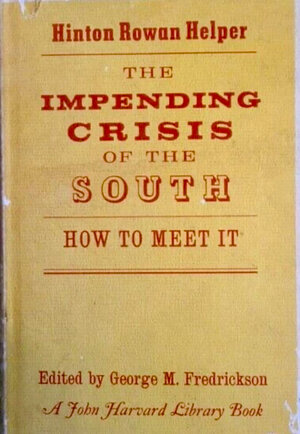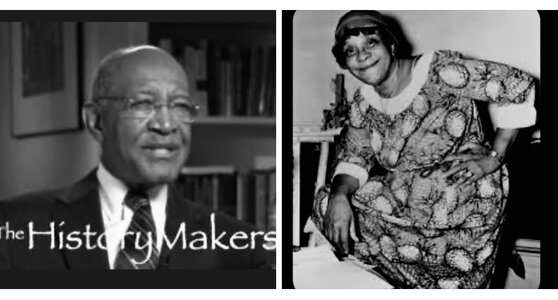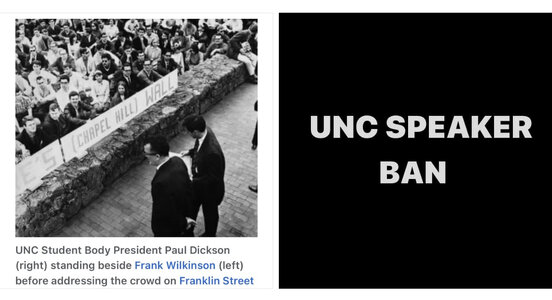(This one needs some work)

The name Hinton Rowan Helper stuck in my memory, as did the title of his 1857 book, ‘The Impending Crisis of The South: How to Meet It,’ from my first read of Hugh T. Lefler’s ‘North Carolina; History, Geography, Government,’ in the 7th grade at
#BonleeElementary. In that text, Lefler depicted H.R. Helper’s book as a catalyst for the enmity between North and South that underpinned the Civil War. Helper, from Davie County, NC, wrote that slavery had impaired the region’s economy, especially the earning possibilities of poor, landless whites. So Helper came out, at least to me from reading Lefler at 13, as an anti-slavery class warrior.
For Lefler he stood for the small farmer and the poor white. Helper was forced out of The South after the 1857 publication of ‘The Impending Crisis’ in fact, and viewed as a traitor to his homeland for fueling the abolitionist arguments. The book was burned and banned throughout the future Confederacy.
Only later did I learn that Helper was a virulent racist and that a good deal of his anti-slavery sentiment stemmed from hatred of African Americans and a desire to see THEM banished from the nation. The more I have read, the more complex becomes the story and Helper’s own ways of seeing come increasingly to represent that of a muddled “thinker.”
Earlier in life, in 1850, before the fame associated with ‘Impending Crisis,’ Helper trekked to California for the Gold Rush and there he encountered a multiplicity of races and ethnicities, brought together as only the glitter of gold can do, and according to historian David Brown, was distressed by the chaotic liberty of it all. Brown goes on to suggest that in California Helper’s racism may have begun to take a more sophisticated form in a pseudo-scientific nod to Darwinism. He also went bust there but did write his first book, ‘Land of Gold’ about that time, fleshing out his vision of the benefits of a racially pure society that would damn him and twist into knots his thinking for the rest of his days.
‘The Impending Crisis’ had value in bolstering the abolitionist argument against the institution of slavery but it also galvanized the Southern Slaveholding class to more deeply play their race cards, lest poor whites in the region recognize that indeed, slavery impoverished all but a very few. An intriguing addendum at least is the life of Hinton R. Helper to current discussions of ‘The Peculiar Institution,’ i.e., slavery, and perhaps a good reminder that recognition of the complexity of humanity always requires revision of the narrative.
In 1861 Lincoln named him Ambassador to Argentina and while there he married an Argentinian. Beginning in 1867 he lived for a time in
#Asheville. It was apparently the only place in the South he felt was safe - indications are that there he went about lonely but unbothered. Sadly his wife lost her eyesight and with their son returned to Buenos Aires. He was involved in a railroad scheme-A Canada to Argentina line-that was a bust. Penniless and alone, an unrepentant racist, he committed suicide at 80 by opening up the gas in his Washington DC flat. There is more to his life - I don’t know much about how the years in South America went.
Late in life he was involved in a railroad scheme-A Canada to Argentina line-that was a bust. Penniless and alone, an unrepentant racist, he committed suicide at 80 by opening up the gas in his Washington DC flat.
And now to the “On This Day” RECAP:
#OTD (June 26) in 1857 the 1st Advertisements for ‘The Impending Crisis of The South’, an economic rebuke of slavery appeared. Lincoln’s GOP embraced the book and pro-slavery forces banned it. Helper painted slaveowners as vile and said that violence in the pursuit of freedom was the right of the enslaved. Helper became a villain in The South. Lincoln appointed him Consul in Buenos Aires (1861-66). After returning to the US from Argentina he lived for a time in
#Asheville#AVL. Also see:
https://www.ncpedia.org/biography/helper-hinton-rowan Over time he grew increasingly racist and committed suicide at 80.




